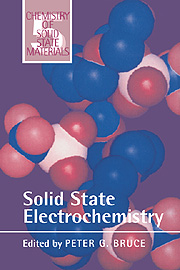Book contents
- Frontmatter
- Contents
- Preface
- 1 Introduction
- 2 Crystalline solid electrolytes I: General considerations and the major materials
- 3 Crystalline solid electrolytes II: Material design
- 4 Ionic transport in glassy electrolytes
- 5 Polymer electrolytes I: General principles
- 6 Polymer electrolytes II: Physical principles
- 7 Insertion electrodes I: Atomic and electronic structure of the hosts and their insertion compounds
- 8 Electrode performance
- 9 Polymer electrodes
- 10 Interfacial electrochemistry
- 11 Applications
- Index
2 - Crystalline solid electrolytes I: General considerations and the major materials
Published online by Cambridge University Press: 14 September 2009
- Frontmatter
- Contents
- Preface
- 1 Introduction
- 2 Crystalline solid electrolytes I: General considerations and the major materials
- 3 Crystalline solid electrolytes II: Material design
- 4 Ionic transport in glassy electrolytes
- 5 Polymer electrolytes I: General principles
- 6 Polymer electrolytes II: Physical principles
- 7 Insertion electrodes I: Atomic and electronic structure of the hosts and their insertion compounds
- 8 Electrode performance
- 9 Polymer electrodes
- 10 Interfacial electrochemistry
- 11 Applications
- Index
Summary
Introduction
High ionic conductivity in crystalline solids is a widely recognised, although still relatively rare, phenomenon. Most ionic solids are electrical insulators unless they exhibit electronic conductivity. They begin to show significant levels of ionic conductivity only at high temperatures, as the melting point is approached. Materials in the family of crystalline solid electrolytes (also called superionic conductors, fast ion conductors or optimised ionic conductors), however, exhibit high conductivity in one of their ionic sublattices – the mobile ion sublattice – at temperatures well below melting and often as low as room temperature.
The first half of this chapter concentrates on the mechanisms of ion conduction. A basic model of ion transport is presented which contains the essential features necessary to describe conduction in the different classes of solid electrolyte. The model is based on the isolated hopping of the mobile ions; in addition, brief mention is made of the influence of ion interactions between both the mobile ions and the immobile ions of the solid lattice (ion hopping) and between different mobile ions. The latter leads to either ion ordering or the formation of a more dynamic structure, the ion atmosphere. It is likely that in solid electrolytes, such ion interactions and cooperative ion movements are important and must be taken into account if a quantitative description of ionic conductivity is to be attempted.
- Type
- Chapter
- Information
- Solid State Electrochemistry , pp. 7 - 42Publisher: Cambridge University PressPrint publication year: 1994
- 1
- Cited by

